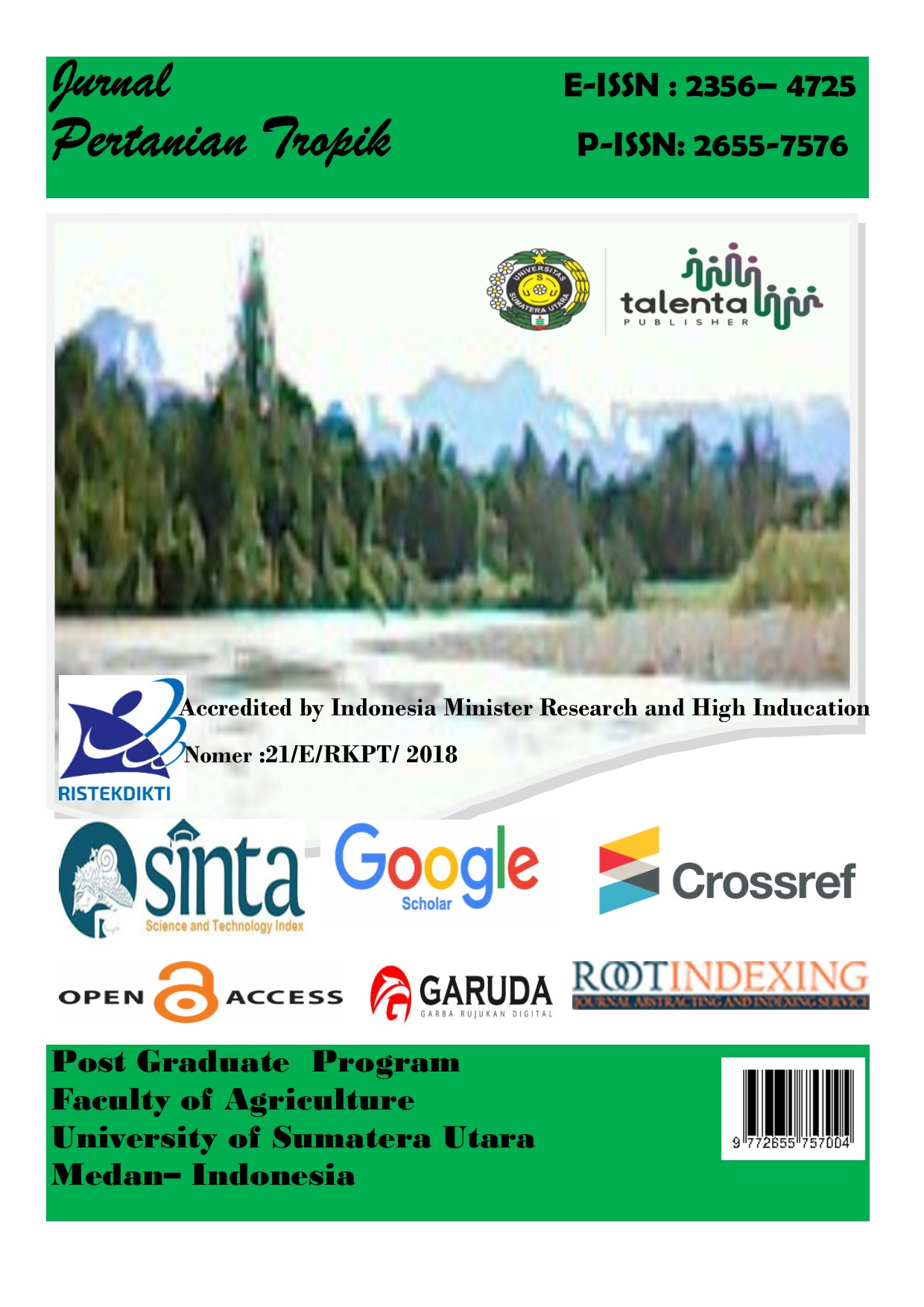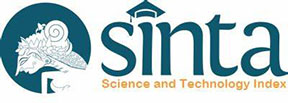Mapping Thickness and Maturity Level Of Peat in The Simpang Wie Village, East-Langsa Sub-district, Langsa City
DOI:
https://doi.org/10.32734/jopt.v7i2.3964Abstract
Food needs become increasingly urgent along with the growth of populations. Indonesian particularly needs more land to be used or utilized to increase food productivity and to create field-work.This view is considered because of the decreasing mineral lands in Indonesian. By conducting a study on the mapping of the thickness and maturity level of peat, it can provide the usage of peatland regarding cultivated land. The result of mapping can appropriately be used to design land utilization and model of production system. This study was carried out at Simpang Wie Village, East-Langsa Sub-district, Langsa City, as known which is known as one of the Peatland areas in Langsa City. The study was conducted in December 2019. Survey method design was employed in this research while the research location was determined purposively, which means that it is directly chosen or purposively chosen because the location is a peatland. Data types applied by field observation in this study were primary and secondary data. In this study, This research requires four main following phases; (1)Preparation (2)Preliminary-Survey (3) Field-Implementation, and (4) Data Analysis/ Discussion. The research result shows that the peatland area width of 4.94 9 (Ha) was classified into two types peat thickness: Shallow/Thin Peat with thickness > 40-100 cm (1.95 Ha), and Moderate Peat with thickness of 101-195 cm (2.99 Ha). Based on the observation, the maturity Level of Peat also classified into two maturity levels, those are Hemic Maturity Level and Sapric Maturity Level. Therefore, the use of peatland area according to thickness and maturity level concluded that the thickness of 40-100 cm can appropriately be used to cultivate paddy-fields, palawijas and plantation crops (horticulture). Besides, the thickness of 101-195 cm can appropriately be used to cultivate plantation crops (horticulture), vegetable crops (olericulture), and fruit crops (fruticulture). At least, this land is suitable to be used for agricultural cultivation because it has hemic and sapric maturity level.
Key words: peat, thickness, maturity level , hemic, sapric, cultivated land
Downloads
References
Agus, F., Subiksa, I.G.M. 2008. Lahan Gambut: Potensi untuk Pertanian dan Aspek Lingkungan. Balai Penelitian Tanah Badan Penelitian dan Pengembangan Pertanian. Bogor.
Agus, F., Wahyunto, Mulyani, A., Dariah A., Maswar, Susanti, E. 2011. Variasi Stock Karbon dan Emisi CO2 di Lahan Gambut. Laporan Tengah Tahun KP3I. Balai Besar Litbang Sumberdaya Lahan Pertanian. Bogor.Indonesia
Andriesse J.P. 1998. Nature and Management of Tropical Peat Soil. FAO, Rome.
Barchia, M., F. 2012. Gambut: Agroekosistem dan Transformasi Karbon. UGM Press. Yogyakarta.
Dariah, Susanti, Erni, Agus Fahmudin. 2011. Simpanan Karbon dan Emisi CO2 Lahan Gambut.Balai Penelitian Tanah. Kementerian Pertanian.
Dariah, Eni, M., Maswar. 2014. Panduan Pengelolaan Berkelanjutan Lahan Gambut Terdegradasi. Hal 16- 29. Badan Penelitian dan Pengembangan Pertanian. Kementerian Pertanian.
Departemen Pertanian Direktorat Pengelolaan Lahan. 2008. Pedoman Teknis Optimasi dan Reklamasi Lahan Pertanian di Kawasan Pengembangan Lahan Lahan
Gambut Kalimantan Tengah Tahun 2008. Departemen Pertanian. Jakarta.
Haryono. 2013. Strategi dan Kebijakan Kementerian Pertanian dalam Optimalisasi Lahan Sub optimal Mendukung Ketahanan Pangan Nasional. Badan Penelitian dan Pengembangan Pertanian. Jakarta. 11 halaman.
Limin, S. H., Saman, T. N., Patricia E. P., Untung, Darung, Layuniyati. 2000. Konsep Pemanfaatan Hutan Rawa Gambut di Kalimantan Tengah. Disampaikan pada “Seminar Nasional Pengelolaan Hutan Rawa Gambut dan Ekspose Hasil Penelitian di Lahan Basahâ€, Diselenggarakan oleh Balai Reboisasi Banjar Baru, Istana Barito Banjarmasin, Kalimantan Selatan, 9 Maret 2000.
Masganti, Yuliani, N. 2009. Arah dan Strategi Pemanfaatan Lahan Gambut di Kota Palangkaraya. Jurnal Agripura. 4(2): 558 571.
Masganti. 2013. Teknologi Inovatif Pengelolaan Lahan Sub-optimal Gambut dan Sulfat Masam untuk Peningkatan Produksi Tanaman Pangan. Jurnal Pengembangan Inovasi Pertanian. 6(4):187-197.
Najiyati, Sri, Lili, Muslihat, I Nyoman, N. S. 2005. Panduan Pengelolaan Lahan Gambut untuk Pertanian Berkelanjutan. Bogor. Wetlands International–IP.
Peraturan Pemerintah Republik Indonesia Nomor 57 Tahun 2016 tentang Perubahan atas
Peraturan Pemerintah Nomor 71 Tahun 2014 tentang Perlindungan dan Pengelolaan Ekosistem Gambut.
Rina, Y, Noorginayuwati. 2007. Persepsi Petani tentang Lahan Gambut dan Pengelolaanya. Hlm 95-1107. dalam Muhlis et.al. (Eds.). Kearifan Lokal Pertanian di Lahan Rawa. Balai Besar Penelitian dan Pengembangan Sumberdaya Lahan Pertanian. Bogor.
Saharjo B.H., Syaufina, L. 2015. Kebakaran Hutan dan Lahan Gambut (Presentasi Power Point). IPN Toolbox Tema C Sub Tema C3. www.cifor.org/IPNtoolbox.
Suryadikarta, D. A., Sutriadi, M., T.2007. Jenis-jenis Lahan Berpotensi untuk Pengembangan di Lahan Rawa. Balai Penelitian Tanah. Bogor.
Suwondo, Supiandi, S., Sumardjo, Bambang, P. 2010. Analisis lingkungan Biofisik Gambut pada Perkebunan Kelapa Sawit. Jurnal Hidrolitan. 1(3) : 20-28.
Wahyunto, K., Nugroho, S., Ritung, Sulaiman, Y. 2014. Indonesian Peatland Map: Method Certainty and Uses. Hlm 81 96. Dalam Wihardjaka, A., Eni, M., Salwati, Husanin, Fahmudin, A. (Eds.). Prosiding Seminar Nasional Pengelolaan lahan Berkelanjutan Gambut Terdegradasi untuk Mitigasi GRK dan Peningkatan Nilai Ekonomi. Balitbangkatan, Kementerian Pertanian.
Widyati, E. 2011. Kajian Optimasi Pengelolaan Lahan Gambut dan Isu Perubahan Iklim. Jurnal Tekno Hutan Tanaman. 4 (2) : 57- 68.
Downloads
Published
How to Cite
Issue
Section
License
Copyright (c) 2020 Jurnal Pertanian Tropik

This work is licensed under a Creative Commons Attribution-ShareAlike 4.0 International License.






















